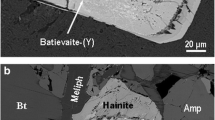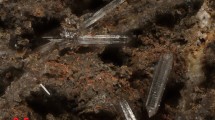Abstract
Dalnegorskite, a new pyroxenoid with the crystal chemical formula Ca2Ca2MnCa(Si3O9)2 and simplified formula Ca5Mn(Si3O9)2, is a rock-forming mineral in the B-bearing calcic skarns in the Dalnegorsk borosilicate deposit (Dalnegorsk, Primorsky Krai, Russia). It belongs to the bustamite structural type and forms a continuous solid-solution series with isostructural ferrobustamite Ca2Ca2FeCa[Si3O9]2. These pyroxenoids form beige, pinkish white and milky white radiated aggregates typically consisting of split thin acicular to fiber-like individuals and are associated with hedenbergite, datolite, andradite, galena, sphalerite, and pyrrhotite. Dmeas. = 3.02(2), Dcalc. = 3.035 g cm–3. Dalnegorskite is biaxial negative, α = 1.640 (3), β = 1.647 (3), γ = 1.650 (3)°, 2Vmeas. = 75(10)°. The average chemical composition of the holotype (electron microprobe data) is: 0.23 MgO, 40.02 CaO, 5.02 MnO, 3.64 FeO, 50.65 SiO2, total 99.56 wt %. The empirical formula calculated for 18 O atoms is Ca5.03Mn0.51Fe0.36Mg0.04Si6.01O18. The crystal structure of the new mineral was obtained from X-ray diffraction data using the Rietveld method, Rp= 0.0345, Rwp = 0.0444, R1 = 0.0790, and wR2 = 0.0802. Dalnegorskite is triclinic, P-1, a = 7.2588(11), b = 7.8574(15), c = 7.8765(6) Å, α = 88.550(15), β = 62.582(15), γ = 76.621(6)°, V = 386.23(11) Å3, and Z = 1. Dalnegorskite is distinct from the related mineral wollastonite in the infrared spectrum. The wave numbers of the maxima of strong bands in the Si–O stretching vibration region in the IR spectrum of dalnegorskite are (cm–1): 905, 937, 1025, and 1070. The holotypic specimen of dalnegorskite is kept in the collection of the Fersman Mineralogical Museum, Russian Academy of Sciences, Moscow, Russia (no. 96201).







Similar content being viewed by others
REFERENCES
Aksenov, S.M., Shchipalkina, N.V., Rastsvetaeva, R.K., Pekov, I.V., Chukanov, N.V., and Yapaskurt, V.O., Iron-rich bustamite from broken Hill, Australia: The crystal structure and cation-ordering features, Cryst. Rep., vol. 60, no. 3, pp. 340–345.
Belov, N.V. and Mamedov, K.S., Crystal structures of wollastonite-group minerals. The crystal structure of xonotlite, Zap. Vsesoyz. Mineral.O-va, 1956, vol. 85, no. 1, pp. 13–38.
Burnham, C.W., Ferrobustamite: the crystal structures of two Ca, Fe bustamite-type pyroxenoids: correction, Z. Krist., 1975, vol. 142, pp. 450–452.
Chukanov, N.V., Aksenov, S.M., Rastsvetaeva, R.K., Van, K.V., Belakovskiy, D.I., Pekov, I.V., Gurzhiy, V.V., Schuller, W., and Ternes, B., Mendigite, Mn2Mn2MnCa(Si3O9)2, a new mineral species from the Eifel volcanic region, Germany, Geol. Ore Deposits, 2015, vol. 57, nos. 8, pp. 721–731.
Chukanov, N.V., Infrared Spectra of Mineral Species: Extended Library, Dordrecht: Springer-Verlag, 2014.
Deer, W.A., Howie, R.A., and Zussman, J., Rock-Forming Minerals. Volume 2a. Single-Chain Silicates, London: Longman, 1978.
Fernandez-Diaz, L., Astilleros, J.M., and Pina, C.M., The morphology of calcite crystals grown in a porous medium doped with divalent cations, Chem. Geol., 2006, vol. 225, pp. 314–321.
Harada, K., Sekino, H., Nagashima, K., Watanabe, T., and Momoi, H., High-iron bustamite and fluorapatite from the Broken Hill mine, New South Wales, Australia, Mineral. Mag., 1974, vol. 39, pp. 601–604.
Kazachenko, V.T., Perevoznikova, E.V., and Narnov, G.A., Accessory mineralization in skarns of the Dalnegorsk ore district (Sikhote-Alin), Zap. Ross. Mineral. O-va, 2012, no. 4, pp. 73–96.
Kurshakova, L.D., Fizikokhimicheskie usloviya obrazovaniya borosilikatnykh mestorozhdenii, (Physical-Chemical Conditions of Origin of Boron-Silicate Deposits), Moscow: Nauka, 1976.
Melnitskaya, E.F., Manganese-iron wollastonite and its alteration, Zap. Vsesoyuz. Mineral.O-va, 1967, vol. 96, no. 3, pp. 297–305.
Mineraly. Spravochnik (Minerals. Reference Book), Chukhrov, F.V. and Smolianinova, N.N., (eds.) Moscow: Nauka, 1981.
Moroshkin, V.V. and Frishman, N.I., Dalnegorsk: notes on mineralogy, Miner. Alm, 2001, no. 4, p. 136.
Ohashi, Y. and Finger, L.W., The role of octahedral cations in pyroxenoid crystal chemistry. I. Bustamite, wollastonite, and pectolite–schizolite–serandite series, Am. Mineral., 1978, vol. 63, pp. 274–288.
Peacor, D.R. and Buerger, M.J., Determination and refinement of the crystal structure of bustamite, CaMnSi2O6, Z. Krist., 1973, vol. 1386, pp. 419–438.
Petříček, V., Dusek, M., and Palatinus, L., Crystallographic Computing System JANA2006: general features, Z. Krist., 2014, vol. 229, no. 5, pp. 345–352.
Punin, Yu.O., Crystal splitting, Zap. Vsesoyuz. Mineral.O-va, 1981, vol. 110, no. 6, pp. 666–686.
Rapoport, P.A. and Burnham, C.W., Ferrobustamite: the crystal structures of two Ca,Fe bustamitetype pyroxenoids, Z. Krist, 1973, vol. 1386, pp. 419–438.
Shannon, R.D. and Prewitt, C.T., Revised values of effective ionic radii, Acta Cryst., 1970, vol. 26, no. 7, pp. 1046–1048.
Shchipalkina, N.V., Kononov, O.V., Pekov, I.V., Koshlyakova, N.N., and Britvin, S.N., Wollastonite and ferrobustamite of the Tyrnyauz ore field (North Caucasus): chemical composition, relations and mineralogical-technological aspect, New Data Miner., 2018, vol. 52, no. 2, pp. 43–50.
Shimazaki, H. and Yamanaka, T., Iron-wollastonite from skarns and its stability relation in the CaSiO3–CaFeSi2O6 join, Geochem. J., 1973, vol. 7, pp. 67–79.
Yamanaka, T., Sadanaga, R., and Takeuchi, Y., Structural variation in the ferrobustamite solid solution, Am. Mineral., 1977, vol. 62, pp. 1216–1224.
Funding
The work was supported by the Russian Foundation for Basic Research (project no. 18-05-00332). IR-spectroscopy was carried out under state assignment (state registration no. 0089-2016-0001).
Author information
Authors and Affiliations
Corresponding authors
Additional information
Translated by E. Maslennikova
Rights and permissions
About this article
Cite this article
Shchipalkina, N.V., Pekov, I.V., Ksenofontov, D.A. et al. Dalnegorskite Ca5Mn(Si3O9)2, a New Pyroxenoid of the Bustamite Structure, a Rock-Forming Mineral of Calcic Skarns in the Dalnegorsk Borosilicate Deposit, Primorsky Krai, Russia. Geol. Ore Deposits 61, 756–766 (2019). https://doi.org/10.1134/S1075701519080105
Received:
Revised:
Accepted:
Published:
Issue Date:
DOI: https://doi.org/10.1134/S1075701519080105




